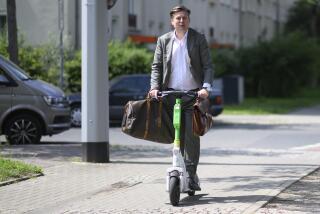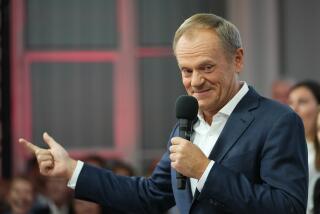Many Candidates but Only 1 Platform in Lithuania : Soviet election: The republic must be independent, most agree. And that makes for a lackluster campaign.
- Share via
VILNIUS, Soviet Union — A visitor doesn’t have to go any farther than the Central Square in front of Communist Party headquarters here in the Lithuanian capital to grasp the significance of today’s republic-wide elections.
Twin signs in the national colors of red, yellow and green--one in Russian, one in Lithuanian--proclaim, “A Lithuania without sovereignty is a Lithuania without a future.”
As little as two years ago, the idea of Lithuanian independence from the Soviet Union was still too radical for public discussion. And it was only a year ago that the powerful grass-roots reform movement known as Sajudis clearly embraced the cause.
Now, most Lithuanian Communists proclaim independence as their goal. And it is clear that the republic’s new Parliament, to be chosen today in the Soviet Union’s first real multi-party elections since 1918, will be pioneers, attempting an unprecedented peaceful secession from the world’s last great empire.
“Of course, the new Parliament will want to put itself in the pages of history and declare independence,” commented Algis Zukas, an aide to Lithuania’s reform Communist president, Algirdas Brazauskas.
More than 80% of the nearly 500 candidates competing for 141 seats in the new Parliament are running on platforms calling for independence. The mood of the ethnic Lithuanian majority in the republic is also clear.
At a campaign debate at a school in the Kosmonautu district of Vilnius the other night, a disgusted Lithuanian woman stormed out after an ethnic Russian candidate running as an unreconstructed Communist rejected a questioner’s contention that the republic is occupied by Moscow.
“I just don’t have the patience to listen to them,” the woman explained. “They just don’t understand Lithuanians.”
Agreement on the independence issue is so widespread, in fact, that the election campaign itself has been relatively unexciting. There are campaign posters around, a lot of political advertising on television and daily public meetings at which opposing candidates answer questions from the constituents.
There is a faint hint of American-style political glitz, such as the reform Communist whose official campaign portrait shows him riding a bicycle in his track suit, or the ethnic Russian who is depicted snuggling his young daughter.
Generally, however, there is such a lack of street rallies or other signs of public enthusiasm that some politicians say they expect many voters will simply stay home.
There aren’t even any juicy vote-rigging scandals or other types of campaign skulduggery so far, according to Election Commission officials.
Recalling the heady political atmosphere that reigned here when Sajudis-backed, non-party candidates trounced the Communists in voting for the national Congress of People’s Deputies last March, editor and People’s Deputy Algimantas Cekuolis commented: “It’s as if a person was hungry for weeks or months. Then he gorged himself, and now he doesn’t want to think of food.”
The political scene has also gotten a lot more complicated here since those earlier elections. The Lithuanian Communist Party split in December after reformers under President Brazauskas divorced themselves from the policies of the national party leadership in Moscow. They jumped aboard the independence bandwagon for fear that otherwise they would be wiped out in today’s elections.
The move won the reformers an immediate boost in the opinion polls and the endorsement by Sajudis of 32 of their candidates for the republic’s Parliament.
Brazauskas, whose campaign literature doesn’t even contain the word communism any more, suddenly has an unprecedented 85% public-approval rating.
Brazauskas aide Zukas said in an interview that the reformed party hopes to win 30% to 40% of the seats in the new legislature.
A half-dozen credible new parties have also appeared since Lithuania became the first Soviet republic to approve a multi-party system late last year. Sajudis, which prefers to remain an umbrella movement rather than become a political party itself, has also endorsed some candidates from those new parties, as well as 92 non-party candidates.
“We are the Alice-in-Wonderland country,” quipped Cekuolis about the profusion and confusion of candidates.
Except for those Communists who still swear allegiance to Moscow--mostly members of the ethnic Russian minority living in Lithuania--the only difference among the rest of the parties is over the form of independence they seek and how hard they are ready to push for it.
“This election will decide at what tempo and what grade of determination we will go to independence,” said Vytautas Landsbergis, chairman of the Sajudis Executive Council.
The reform Communists are cautious.
“Even in the United States, it took years after the Declaration of Independence for this independence to become a fact of life,” Brazauskas said in an interview with a Lithuanian newspaper earlier this month. “So, I am ready for a difficult road ahead on the way to our goal.”
“The question is not independence,” Zukas said. “It’s more how we are going to achieve it. The (reform) Communist Party is for achieving it in small steps.”
The Social Democrats, under economist Kazimieras Antanivicius, 52, have no apparent quarrel with the reform Communists’ program but are anxious to disassociate themselves from any part in the old system.
“We’re for getting rid of the kind of socialism that existed here for 70 years,” Antanivicius told about 150 people at a defense-plant social club the other day. “That socialism was slavery. It was worse than feudalism.”
More to the right are the Christian Democrats, Democrats and the most radical Lithuanian Freedom League, which argues that the current leadership of both the reformist Communists and Sajudis have so discredited themselves by past compromise with the system that they are unfit to lead the way to independence.
With so few issues involved, the race focuses heavily on personalities.
The final list of candidates makes it clear that the largely inexperienced politicians who will be trying soon to negotiate Lithuania’s independence will be a highly educated, mostly male and middle-aged lot.
Nearly 94% of them have college degrees, an extraordinary figure in a country where workers and peasants have long been allotted seats in government.
Only 28 of the candidates are women. “This is different from all previous elections, when the number of women was fixed from above,” said Sajudis Election Committee official Angonita Rupsyte. Also, she said, noting the hardships of everyday life in Lithuania, “it’s very difficult to harmonize a family and politics in our conditions.”
About one-third of the candidates are under 40, another third 40 to 50 and the rest over 50.
Final results of the elections may be some time coming. Run-offs may be required in many constituencies if fewer than half the registered voters turn up or no candidate manages to win more than 50% of the votes.
It is expected that the elections will result in the first coalition government in the Soviet Union since shortly after the Bolshevik Revolution. And that government will try to negotiate the terms of Lithuania’s independence with Moscow.
Perhaps the most encouraging news on that front came out of Paris this week, where an aide to President Mikhail S. Gorbachev said no one could prevent Lithuania’s seceding from the Soviet Union.
Aide Andrei Grachev said he hopes that all three Baltic republics can be convinced that it is in their interest to remain in a revitalized Soviet federation.
“But if this discussion doesn’t convince the Lithuanian people that their interest is to remain within a renewed federation, they make the decision, and no one can prevent them from fulfilling it,” Grachev said.
BACKGROUND
The Baltic states of Lithuania, Latvia and Estonia were independent countries from just after World War I until they were annexed by the Soviet Union in 1940. Under a secret protocol to a 1939 nonaggression treaty between Josef Stalin’s Communist regime and Adolf Hitler’s Nazi Germany, the Communist and Fascist powers had conspired to carve up Eastern Europe into areas of control. Soviet military units began occupying the three nations that year. Annexation was completed after “elections” that purportedly supported the Soviet takeover. The nonaggression pact was abrogated on June 22, 1941, when Nazi forces attacked the Soviet Union.
More to Read
Sign up for Essential California
The most important California stories and recommendations in your inbox every morning.
You may occasionally receive promotional content from the Los Angeles Times.










